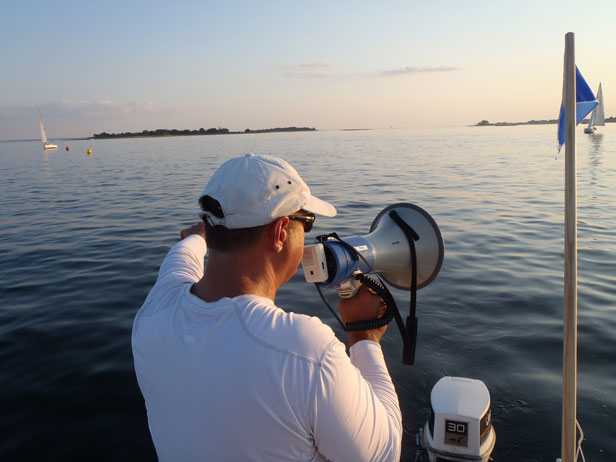Courses
The normal course will be a 3-5 minute upwind leg, a 1-3 minute broad reach, a second 1-3 minute broad reach, round a downwind mark, and a final 30 – 60 second upwind leg to the finish. All mark roundings will normally be to port. The starting / finish line will normally be between an orange float or the committee boat on the starboard side, and the pin end (a pick up float) to port.
Starts
3 long blasts
3 minute warning
2 long blasts
2 minute warning
1 long blast
1 minute warning
3 short blasts
30 seconds
1 short blast
start
5 short blasts
recall (will occur if no boats start within 15 seconds of the starting gun or a wind change makes the start difficult)
Port Tack Starts are NOT ALLOWED until after all starboard tack boats have started.
General Hints
a. Before the start, sail on a beam reach 30-60 seconds away from the preferred starting line position, note your position, and make sure you are there 30-60 seconds to the start. You should also head to wind to figure which end of the line is favored.
b. Finding the Favored End: Joe sails his Ensign head-to-wind in the middle of the starting line to see which end his bow favors. If his bow points more toward the committee boat, that end is favored. If it were to point more toward the pin end, that end would be favored.
c. At the starting gun, be moving at full speed on the line with clear air for the immediately foreseeable future.
d. Sail toward the favored side of the course with a wide lane of clear air. Consider the current, which slows as you get farther from the main channel.
e. Weight forward, motor all the way up, keep the jib tell tails flying with the leech just touching the shroud, and the boom end about 18” off centerline when sailing upwind.
The Ensign Racing Rules
1. Port keeps clear of starboard.
When boats are on opposite tacks, the boat on the port tack (boat with the boom over its right side) must stay clear of any boats on the starboard tack (boat with the boom on its left side).
2. Windward keeps clear of leeward.
When overlapped (when any portion of one boat is even with the hull of the other boat) the boat to windward must stay clear of the boat to leeward.
3. The boat astern keeps clear of the boat ahead.
A boat clear astern (for example, behind without an overlap) must stay away of a boat clear ahead. If two boat are on starboard tack, one going upwind and one downwind, the boat behind must give way.
4. A boat tacking or jibing keeps clear of one that is not.
When a right of way boat changes course she shall give the give way boats room to keep clear.
5. If you gain right of way by changing course, give the other boat time to keep clear.
When a boat gains the right of way by her actions she shall give the newly burdened boat the room to keep clear for at least 20 seconds after her sails are set for the new course (i.e. – you tack to starboard and are leeward of another boat; you must wait 20 seconds before asking them to head up).
6. Rounding Marks
a. When boats are about to round a mark, the outside boat must give each boat overlapping her on the inside room to round the mark. At a windward mark, this only applies if the boats are on the same tack. At the reaching / downwind marks, this applies to boats on opposite tacks as well. The overlap must occur within 2 boat lengths to the mark, and the inside boat must call for “Overlap, Room at the Mark”. If the overlap happen with less than 2 boat lengths to the mark, the inside boat has no right to room, and must stay clear.
b. If a boat touches a mark it is rounding or a mark that is part of the starting line, it must do a 360 degree turn to clear itself of the infraction while staying clear of other boats before rounding the next mark.
7. Other Rules
a. Hiking is not allowed. When sailing upwind, ‘cheeks on the teak,’ in this case, the cockpit seats. No one allowed outside the cockpit except to clear fouled lines.
b. When sailing downwind, one person may hold the jib sheets out, as long as the boom is also restrained. Crew may be on the foredeck.
c. Port tack starts not allowed until all starboard tack boats have started.
d. If an instructor is the skipper, they may not cross the line until 10 seconds after the starting gun. If they are not the skipper, they must not touch the helm except to avoid a collision.
8. Protests & Infringements
a. A right of way boat shall, if at all possible, avoid acollision with a give way boat, and shall have the right to protest the give way boat, by waving a red life jacket and informing the give way boat, saying; “I Protest (name of boat).” If the give way boat agrees, by verbally informing the right of way boat and raising a red life jacket, she may do a 360 at any point before the end of the race.
b. If the give way boat does not agree, she shall immediately inform the protesting vessel and the race committee. The race committee will render an immediate decision, possibly by asking for comments from nearby boats, and a 720 turn must be performed by the give way boat within 30 seconds of the decision should it not be favorable to the give way boat.
c. Any contact requires the boat that did not have right of way to execute a 720 turn before the end of the race, pay a minimum penalty of $40 plus the cost of all repairs.

